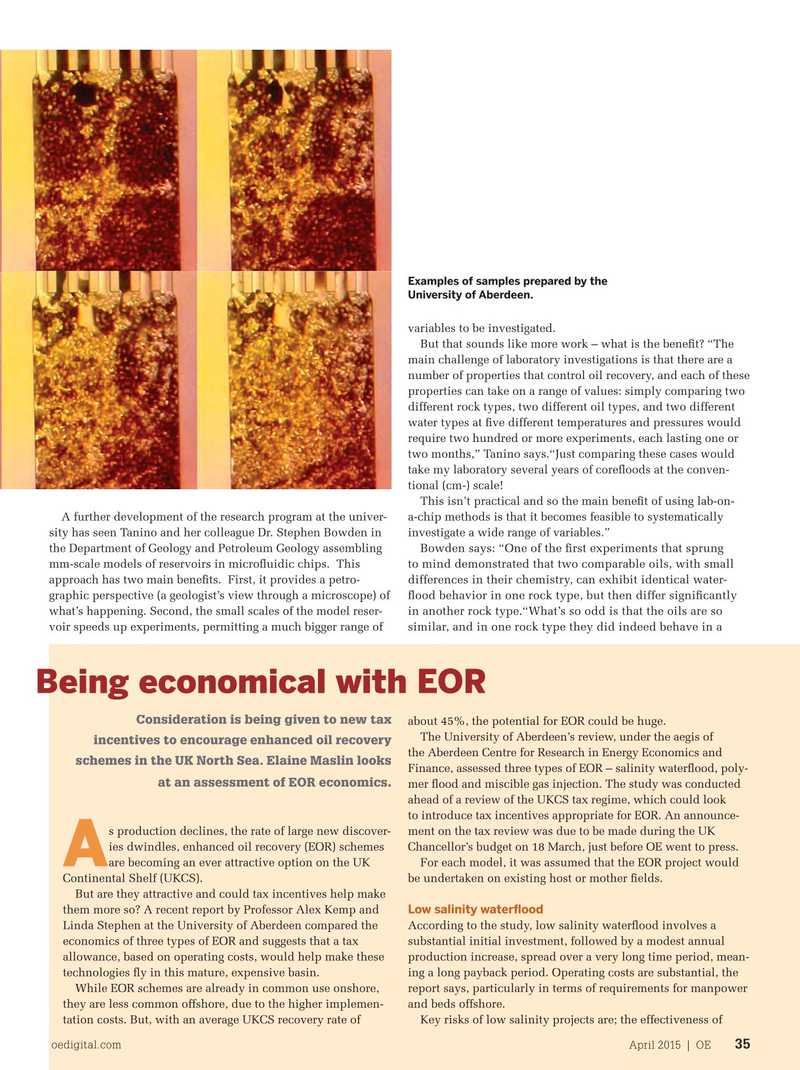
Page 33: of Offshore Engineer Magazine (Apr/May 2015)
Read this page in Pdf, Flash or Html5 edition of Apr/May 2015 Offshore Engineer Magazine
Examples of samples prepared by the
University of Aberdeen.
variables to be investigated.
But that sounds like more work – what is the beneft? “The main challenge of laboratory investigations is that there are a number of properties that control oil recovery, and each of these properties can take on a range of values: simply comparing two different rock types, two different oil types, and two different water types at fve different temperatures and pressures would require two hundred or more experiments, each lasting one or two months,” Tanino says.“Just comparing these cases would take my laboratory several years of corefoods at the conven- tional (cm-) scale!
This isn’t practical and so the main beneft of using lab-on-
What’s more, they’re A further development of the research program at the univer- a-chip methods is that it becomes feasible to systematically also looking at how sity has seen Tanino and her colleague Dr. Stephen Bowden in investigate a wide range of variables.”
Bowden says: “One of the frst experiments that sprung oils with different the Department of Geology and Petroleum Geology assembling to mind demonstrated that two comparable oils, with small chemical compositions mm-scale models of reservoirs in microfuidic chips. This differences in their chemistry, can exhibit identical water- interact with rocks of approach has two main benefts. First, it provides a petro- food behavior in one rock type, but then differ signifcantly different compositions graphic perspective (a geologist’s view through a microscope) of in another rock type.“What’s so odd is that the oils are so to infuence reservoir what’s happening. Second, the small scales of the model reser- similar, and in one rock type they did indeed behave in a wettability. voir speeds up experiments, permitting a much bigger range of
It’s complex work, but understanding the fundamentals
Being economical with EOR will help the industry to understand why
Consideration is being given to new tax what they’re doing about 45%, the potential for EOR could be huge. works – or not, says Dr. The University of Aberdeen’s review, under the aegis of incentives to encourage enhanced oil recovery
Yukie Tanino, lecturer the Aberdeen Centre for Research in Energy Economics and schemes in the UK North Sea. Elaine Maslin looks at the university in Finance, assessed three types of EOR – salinity waterfood, poly- .
at an assessment of EOR economics the Environmental mer food and miscible gas injection. The study was conducted & Industrial Fluid Mechanics Group in the School of ahead of a review of the UKCS tax regime, which could look
Engineering.“What is the optimal reservoir wettability for oil to introduce tax incentives appropriate for EOR. An announce- recovery,” she asks. “Once we can answer that we can think s production declines, the rate of large new discover- ment on the tax review was due to be made during the UK about how we can achieve that wettability using conventional ies dwindles, enhanced oil recovery (EOR) schemes Chancellor’s budget on 18 March, just before OE went to press.
A
EOR methods.” are becoming an ever attractive option on the UK For each model, it was assumed that the EOR project would
Wettability is key to understanding fuid fow in the reservoir Continental Shelf (UKCS). be undertaken on existing host or mother felds. as it controls where fuids are distributed at the pore-scale. But are they attractive and could tax incentives help make
Low salinity waterfood
Some surfaces repel water (hydrophobic, or “oil-wet”) and them more so? A recent report by Professor Alex Kemp and some repel oil (hydrophilic, or “water-wet”). The university is Linda Stephen at the University of Aberdeen compared the According to the study, low salinity waterfood involves a carrying out corefoods using synthetic oil to simulate different economics of three types of EOR and suggests that a tax substantial initial investment, followed by a modest annual wettability scenarios in the lab.The main focus so far has been allowance, based on operating costs, would help make these production increase, spread over a very long time period, mean- on identifying quantitatively correlations between wettability, technologies fy in this mature, expensive basin. ing a long payback period. Operating costs are substantial, the as characterized by the contact angle of oil-contacted grain sur- While EOR schemes are already in common use onshore, report says, particularly in terms of requirements for manpower faces, and waterfood oil recovery. Future work will focus on they are less common offshore, due to the higher implemen- and beds offshore. chemical signatures of wettability inversion during waterfoods. tation costs. But, with an average UKCS recovery rate of Key risks of low salinity projects are; the effectiveness of oedigital.com April 2015 | OE 35 034-OE0415_Feat1_Aberdeen U.indd 35 3/23/15 2:25 PM

 32
32

 34
34